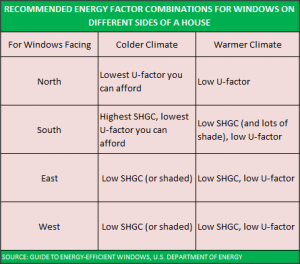The 2015 Remodeling/Realtor Cost vs. Value Survey reports that typical replacement window projects cost homeowners between $11,198 and $17,422. When reselling their homes, the study says the owners can expect to recover 72 to 79 percent of their investment in replacement windows.
If owners upgrade to replacement windows rated by the National Fenestration Rating Council (NFRC) under the EPA Energy Star program and stay in their homes after the job is done, they’re likely to enjoy additional payback in the form of lower energy bills over the years. The U.S. Department of Energy estimates annual energy-cost savings of $71 to $501 when rated windows are installed. Rated windows bear a label that looks like this:
NFRC rates windows in a number of areas—two have the most bearing on their energy performance:
- U-factor: A fraction that expresses a window’s overall insulating performance based on its frame material and glazing
- Solar Heat Gain Coefficient (SHGC): A fraction that expresses the amount of solar radiation a window admits through the glass
Generally speaking, the lower the U-factor, the better for any window in any climate. But Energy Star standards take into account the relationship between a window’s U-factor and SHGC in evaluating the potential benefits of particular windows in different climates. To state it simply, in cold climates windows with a low U-factor and a high SHGC (which maximizes passive heat gain) are most likely to promote energy savings during winter months. In warmer climates, windows with a higher U-factor will serve well as long as the SHGC is low. The key question in parsing the ratings is: How do you spend the bulk of your energy dollars—on heating or cooling?
The analysis can be taken even further by refining window selection not only by climate but also by orientation of windows with respect to the sun on different sides of a house. Energy Star has the following recommendations:
 Of course, annual energy costs for a given home in a given year fluctuate with rates and weather. While the actual savings from investments in replacement windows are difficult to project with great accuracy, you’ll get the best bang from your energy buck by following the DOE recommendations as closely as possible.
Of course, annual energy costs for a given home in a given year fluctuate with rates and weather. While the actual savings from investments in replacement windows are difficult to project with great accuracy, you’ll get the best bang from your energy buck by following the DOE recommendations as closely as possible.
Michael Chotiner is a construction industry veteran who writes on window installation and other homeowner topics for The Home Depot. Michael has been a general contractor for many years, and is also a master cabinet maker.